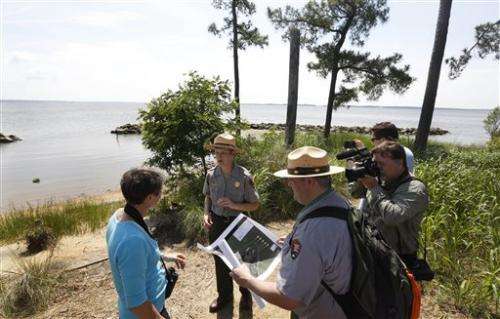Interior chief: Jamestown at risk from rising seas

Jamestown Island, America's oldest known permanent European settlement runs the risk of being swept away by rising seas, with some sections of it already beneath the James River.
Interior Secretary Sally Jewell got a firsthand look Thursday at the effect of climate change on ever-receding coastline Jamestown Island, Virgina.
Jewell trekked around the island, and heard of the devastation in 2003 when Hurricane Isabel raked the low-lying landscape. The storm left many parts of the island underwater and destroyed thousands of artifacts retrieved from archaeological digs. Many are still being restored.
Jewell told the Associated Press that Jamestown is certainly vulnerable.
"I know enough now having been in this job looking at vulnerable sites that this is a highly vulnerable site," Jewell said. "We don't have very many places in the United States that talk about the super-early history of settlers connecting with the native people of the land, so this is a really an important place."
Dorothy Geyer, a Park Service natural resource specialist, said a 1 1/2-foot (0.5 meter)rise in sea level would put 60 percent of the island under water and a 4-foot (1.2-meter)-plus rise would increase that number to 80 percent.
Jewell said her visit to Jamestown is part of the Obama administration's push to address climate change.
"It's very clear we have global warming and sea level rise and this is a hot spot for it," Jewell said. "And what's at risk is the history of our country."
Jamestown was settled in 1607 by Europeans, including Capt. John Smith. When European settlers arrived, there already was a thriving population of Native Americans led by paramount Chief Powhatan. The remnants of both native people and settlers can be found on the island.
The Tidewater of Virginia and sections of the Chesapeake Bay are among the most vulnerable to sea change in the world. While climate change is a big factor, the region is also sinking—the result of a meteor that gouged out the Chesapeake Bay 35 million years ago.
The tour followed a report in May by the Union of Concerned Scientists that lists Jamestown as among 30 historic and cultural sites in the nation that are at risk because of climate change.
Jewell trekked through mosquito-infested wetlands and through stands of loblolly during the tour. At Black Point, the eastern-most point of land on the island, she saw where waters had reclaimed 20 feet (6 meters) of the island through the years.
Jewell visited a research center where thousands of artifacts are still being restored. More than 1 million artifacts—pipe stems, ceramic cookware, silver settings—were damaged. Jewell later had discussions with climate scientists.
© 2014 The Associated Press. All rights reserved.




















